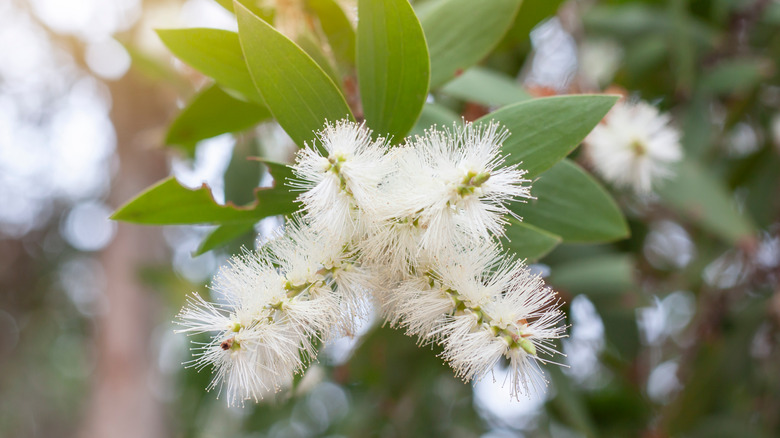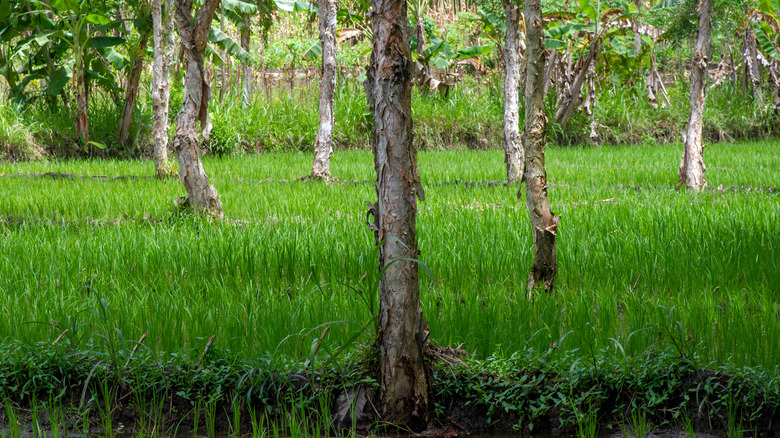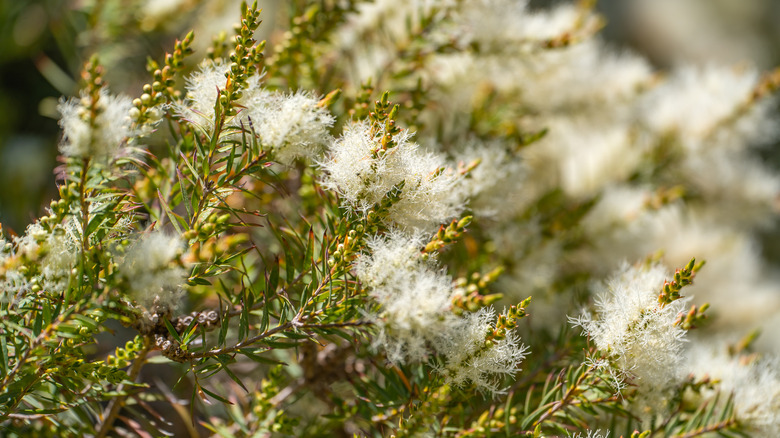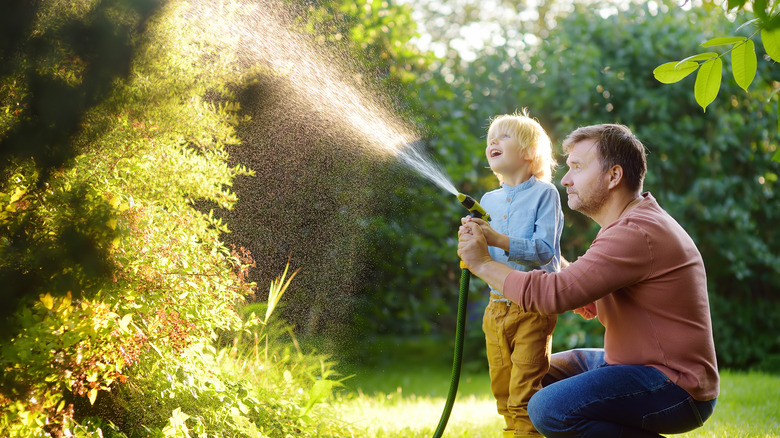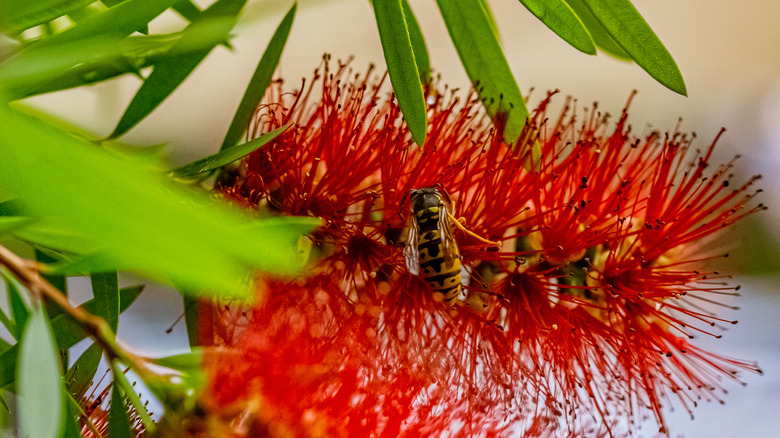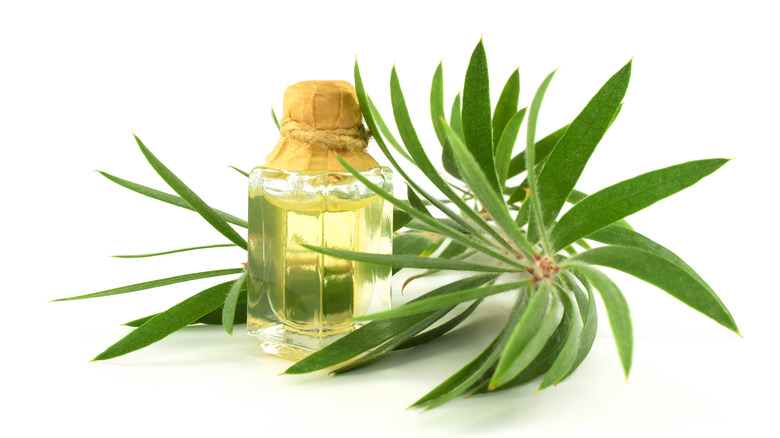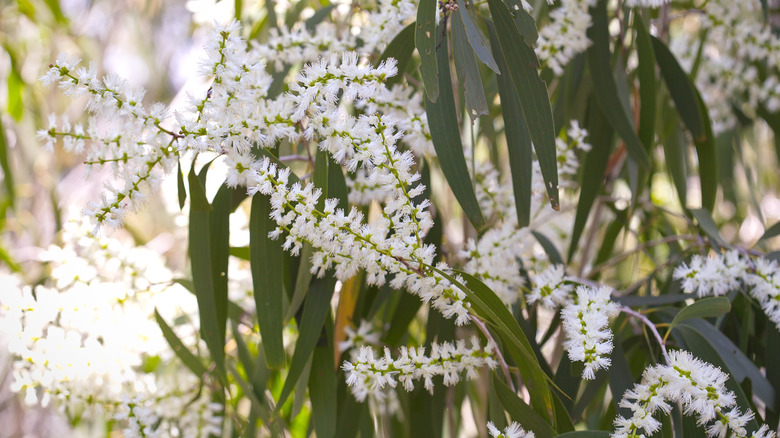How To Grow And Care For A Melaleuca Tree
The Melaleuca quinquenervia, more commonly known as the melaleuca tree, is identified by its papery bark that peels back in layers from the trunk of the tree. They grow rather tall, often reaching 80 feet high, and produce long, thin oval leaves that are evergreen and can grow up to 5 inches long. Each leaf is a beautiful shade of green and is lined with parallel veins that run between the two farthest ends of the leaf. In the spring, melaleuca trees bloom with long, white, brush-like flowers that turn into hard seed capsules in the summer, according to the University of Florida.
Florida Fish and Wildlife Conservation Commission states that the tree originated from New Guinea and Australia, but now can be found abundantly in many parts of Florida, particularly Central and South Florida. After being brought to the states in 1906, it was planned to be used for commercial timber. Beyond timber, the tree also became popular for landscaping. However, the melaleuca tree grew so well in Florida that entire forests of these trees naturally developed and were quickly considered to be invasive species. They disrupted the natural flow of water through many areas and became a fire hazard due to the flammable oil their leaves possess. Without a special license, these trees are now illegal to sell and plant in the state of Florida. If you are intrigued by this plant, read on to see how you can safely grow and maintain these hazardous trees for yourself.
How to use melaleuca tree in garden
Before making the decision to add a melaleuca tree to your garden, ensure you understand the risks of owning this hazardous and invasive species of tree. It is not recommended for planting anywhere in the state of Florida or in areas with Florida-like conditions. If, however, you deem your locale to be a safe place to house this unique species, you can bring a rare, exotic look to your garden, states All About Gardening.
A melaleuca tree can make a beautiful focal point in your garden. They are most commonly used in rather large yards and parks due to their massive size but can grow just as beautifully in smaller gardens with the right amount of allotted space. Their large size also makes them a perfect source of shade, when looking for the ideal position to place a small outdoor sitting area. Along with their grand stature, they also bring a variety of textures to your yard between their flaky bark and brush-like flowers that emerge in the spring. The tree is a unique, pinnacle of beauty, but still, it needs to be grown with certain precautions.
How to grow a melaleuca tree
According to Australian National Herbarium, melaleuca trees can be grown from either seeds or a cutting from the tree. From the seed, the tree is relatively easy to grow. When collecting the seeds, ensure you collect them from seed capsules that are at least one year old. From there, All About Gardening states that the capsules should be kept in a warm environment until the seeds release naturally. The seeds should then be planted in a thin layer of soil and left alone for approximately fourteen days as the seeds germinate. After the seeds sprout, allow them to continue growing in a protected environment for a few more months before transferring them to your garden or potted environment.
When propagating the melaleuca tree from a cutting, All About Gardening recommends locating a healthy branch on the tree and cutting a 75 to 100 millimeter cutting from the stem. When you retrieve the cutting, remove leaves and small stems from the lower half of the cutting. Removing the flacking bark away from the lower portion of the branch also proves to have positive effects on the propagation process. When ready, dip the lower end of the cutting in a root growth hormone before planting it firmly in a pot filled with a propagation mixture. Within six to seven weeks, the roots should begin to develop from the cutting. Once the roots are strong enough, the new plant can then be transplanted to its permanent position.
How to care for a melaleuca tree
When it comes to caring for a melaleuca tree, the surrounding temperature is very important. For a melaleuca tree to survive it needs to be in a relatively warm environment. Gardening Know How recommends only planting this tree permanently outside in your garden if you live in a plant hardiness zone of 8 or above. If you don't live in a warm climate, it is recommended to plant your melaleuca tree in a pot or container. This allows you to transition your plant to a warmer, indoor location when the weather in your area becomes cooler. Whether you grow your tree in your garden or in a potted environment, it is still important to ensure the plant receives plenty of sunlight. Melaleuca trees do not like the shade; therefore, ensure they are always placed in a position where they can receive full to a partial amount of sun.
When planting your melaleuca tree in its permanent or potted position, it's important to know what kind of soil the plant will best thrive in. The melaleuca tree enjoys rather acidic soil, you can mix in peat moss if you currently have neutral soil. It is also important to ensure that the soil in which the tree is planted is well-draining. With proper drainage, you should also ensure your tree receives plenty of water. Melaleuca trees do not like to dry out; therefore, always ensure your tree receives water, especially when the weather is dry.
Melaleuca tree varieties
Melaleuca varieties are abundant, according to Australian Native Plants. These varieties range in size and color, bringing a unique look to your garden. Let's take a closer look at some of the more popular melaleuca trees.
- Tottum pole (Melaleuca decussata) – grows into a shrub or petite tree with beautiful purple, brush-like flowers.
- Granite honey myrtle (Melaleuca elliptica) – known for tolerating periods of drought and frost and producing vibrant, magenta brush-like flowers.
- Scarlet honey myrtle (Melaleuca fulgens) – produces small green leaves and little orange flowers and is commonly known for attracting hummingbirds.
- Desert honey myrtle (Melaleuca glomerata) – a 6- to 15-foot shrub with lots of stems, known for surviving a variety of weather changes and blooms creamy yellow, brush-like flowers in the summer.
- Hillock bush (Melaleuca hypericifolia) – boasts small bright green leaves with vibrant red, brush-like flowers that bloom at the beginning of summer.
- Weeping paperbark (Melaleuca irbyana) – grows into a flaky bark tree with the tendency to weep, the stems grow long with small green leaves and scented flowers that appear between the seasons of winter and spring.
- Violet honey myrtle (Melaleuca wilsonii) – considered to be very adaptable to a variety of environments while keeping rather low to the ground in a screen or hedge form.
- Wattle honey myrtle (Melaleuca micromera) – grows in a unique vertical fashion with twisted branches that are covered in scaly green leaves, and produces yellow flowers in the spring and summer.
Are melaleuca trees toxic?
As mentioned before, the melaleuca tree is known for being a hazardous tree due to the highly flammable oil that comes from its leaves. This oil, however, has many proven health benefits when used externally for issues like dandruff, acne, athlete's foot, lice, and nail fungus. Despite the benefits, the oil still needs to be used with precautions. Even when applied externally, Mayo Clinic states that skin irritations and conditions can emerge from its use. When ingested, the oil also becomes highly toxic, causing confusion, lack of muscle control, and loss of consciousness.
Household pets are also at risk from the toxic effects of melaleuca oil. Healthy Paws states that in highly concentrated amounts, regardless of if it's used externally or internally, the oil can have harsh effects on animals. If your pet has been exposed to the oil, it is recommended to thoroughly wash your pet with soap and water and monitor them carefully for the following week. For large amounts of exposure, it is also recommended to call or take your pet to the nearest veterinarian.
How to repot a melaleuca tree
Most varieties of melaleuca trees tend to grow rather large in a short period of time; therefore, if grown in a potted environment, they must be repotted rather frequently. When you find that your melaleuca tree is ready for a new pot, All About Gardening recommends purchasing a quality potting soil mixture for the tree and a spacious planter with drainage holes at the bottom. To prepare the pot, place a layer of soil in the lower part of the pot, which can be adjusted to the height of the plant.
After extracting the melaleuca tree from its current pot, ensure you tease and shake out the roots before placing it in the newly prepared pot. Fill in the gaps with more soil and pat everything down firmly before thoroughly watering. It should be watered enough that you see water draining from the bottom drainage holes. To retain moisture, when you have finished watering you can add a layer of mulch to the surface of the pot. Finally, find a full-sun or a partially shaded position outside or inside your home as the plant recovers from its transition and begins to thrive again.
